Is our culture falling apart right on time?
Sometime around the year 2005, perhaps a few years before or after, America will enter the Fourth Turning… a spark will ignite a new mood…
In retrospect, the spark might seem as ominous as a financial crash, as ordinary as a national election, or as trivial as a Tea Party…
[T]he following circa-2005 scenarios might seem plausible:
A global terrorist group blows up an aircraft and announces it possesses portable nuclear weapons… Congress declares war… opponents charge that the president concocted the emergency for political purposes.
An impasse over the federal budget reaches a stalemate. The President and Congress both refuse to back down, triggering a near-total government shutdown… Congress refuses to raise the debt ceiling. Default looms. Wall Street panics…
— William Strauss and Neil Howe, The Fourth Turning (1996).
As skeptical as I generally am about historical determinism and waves/cycles, I have to admit that I found the thesis of The Fourth Turning both intriguing and compelling. [Ed. Note: We have discussed this before: here and here]. It’s not just an assertion that certain kinds of events tend to happen every so often, but an explanation of why. The authors of the best-seller Generations argue that not only do generations have an archetype or ‘personality’,* but that the interaction of those personalities ensures that an event that might be all but ignored in one era will cause a crisis in another. Just as one person might blow off an insult where another makes a blood feud of it, so do generations react to different stimuli differently.
Strauss and Howe’s cycle is called the Saeculum, which is loosely Latin for a long human lifetime. Like the Kondrateiff Wave, each complete cycle is broken into four seasons. Unlike the K-Wave, these seasons are not merely economic, but social in every sense of the term. Society moves through a series of changes, with each successive generation molded by and reacting to the one that preceded it. The results can be found in matters social, civic, familial, and economic.
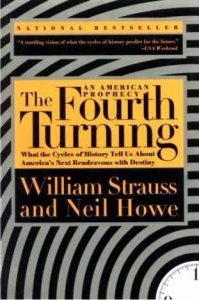
These four seasons of the Saeculum are separated by turnings, short periods of often violent and shocking transition. Each cycle starts with a First Turning that raises society from the depths of crisis into a spring-like high where everything is awesome (e.g. 1946-64). A Second Turning then rolls an unsuspecting nation into a summer-like Consciousness Revolution (e.g. 1964-84), in which a rising generation tries to find meaning in the prior generation’s creation. Failing, they rebel against the sterility and conformity that provided such comfort to their fathers. Summer’s Third Turning rolls into an autumn Culture War (e.g. 1985 – ~2005) where the exposed contradictions fuel a society-wide struggle over values. Finally, a Fourth Turning – kicked off by a clear event, or catalyst – brings a winter-time crisis that burns it all to the ground, resolves the contradictions, and sets the stage for a First Turning into a new Spring.
Previous Fourth Turning crises include The Wars of the Roses (1459-87), the Armada Crisis (1569-94), the Glorious Revolution (1675-1704), the American Revolution (1773-1794), the Civil War (1860-65), and the Depression and WWII (1929-1946), each burning down the prior order and establishing something wholly new in its place.
Strauss and Howe assert something new is coming once again, just as it always has, though writing a decade before they expected to see it, they have only guesses as to what it might look like. Of course, much of the fun of reading a book like this lies in just that kind of guessing. And since this book turned 20 years old last year, we’ve had plenty of time to measure whether its prophecies are accurate. So far, the answer is a firm and resounding maybe.
The catalyst that would kick off the current Fourth Turning, bringing us into a 20-year period of crisis and destruction and setting the stage for renewal, should have struck a couple years on either side of 2005. It had to light a fire big enough that its flames would burn for 20 years and change us entirely as a people. One early guess of the event was 9/11. It had all the makings of the kind of catalyst that could re-make society.
However, co-author Neil Howe is now certain that the catalyst is the 2008 Financial Crisis. Our modern debt-based financial system could be consumed because it is built on a foundation of wishes and fraud, and when it burns, it has the potential to incinerate the entire modern world. That’s the kind of thing a Fourth Turning does.
The Fourth Turning has some weaknesses as a theory of history. For example, following the Civil War it skips an entire generation, compressing 40 years of cycle into 5. Given the explanation that generations react in predictable ways to the one prior, skipping an entire generation like that undermines what is otherwise a reasonable assertion. The theory also seems to at least imply that the turning begins in earnest immediately following the catalyst, yet here we are a decade years after the 2008 crisis, treading water while printing fake money to inflate our lifejacket. I suspect that whatever breaks us out of our current economic stasis will be perceived as the real catalyst a decade late.
Whether the crisis we are facing is due to a Fourth Turning or just human sin and stupidity may be a distinction without a difference. And at least Strauss and Howe’s book gives some assurance that there may be light at the end of the tunnel, a new societal high in our near future.
May be. For here is the paragraph that follows the Fourth Turning introduction above:
The risk of catastrophe will be very high. The nation could erupt into insurrection or civil violence, crack up geographically, or succumb to authoritarian rule. If there is a war, it is likely to be one of maximum risk and effort – in other words, a total war. Every Fourth Turning has registered an upward ratchet in the technology of destruction, and in mankind’s willingness to use it.
The possibility exists that prepping and prayer will be enough to see us through to a new spring, where everything is awesome again and all the children are above average. But it may just carry us through a transition into what seems like eternal winter.
Plant a tree anyway.
* Anyone who has ever muttered the phrase “#@&%ing Boomers” under his breath is already on board with this concept.

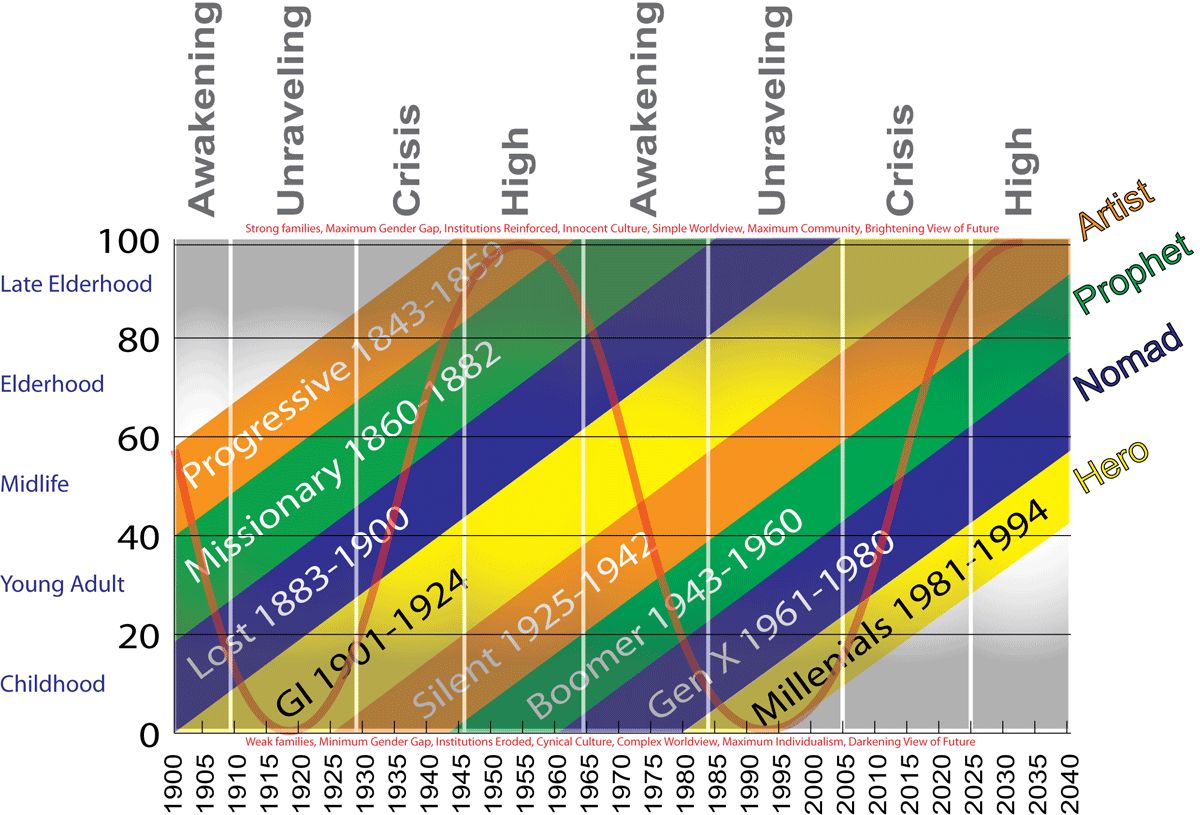

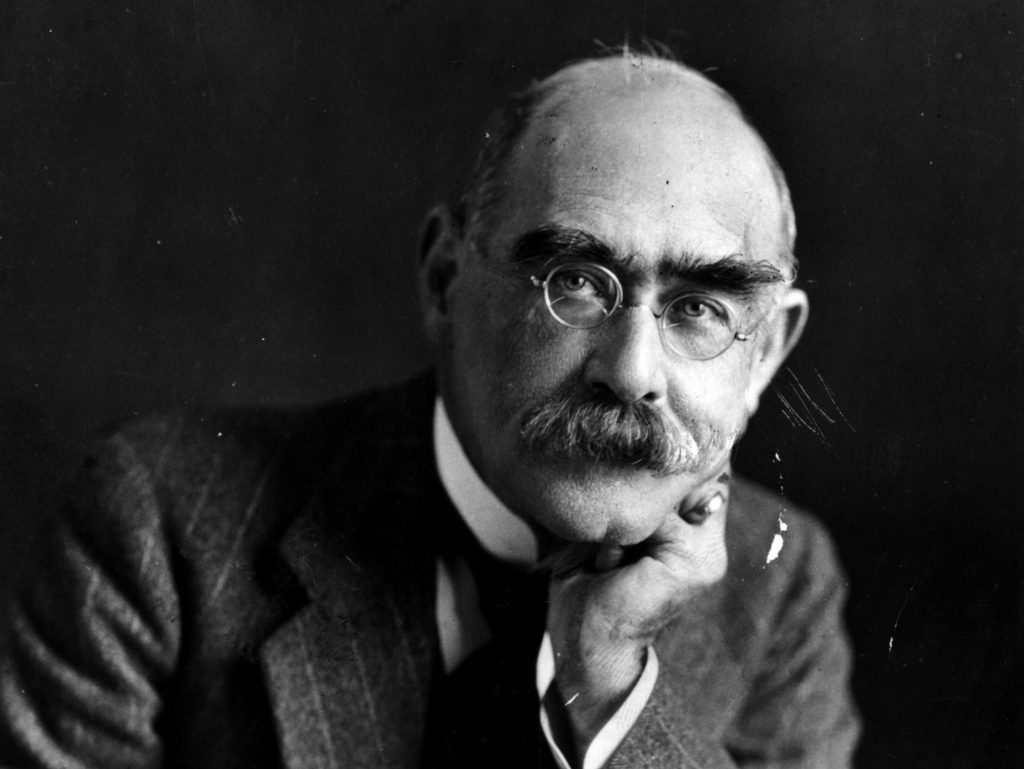
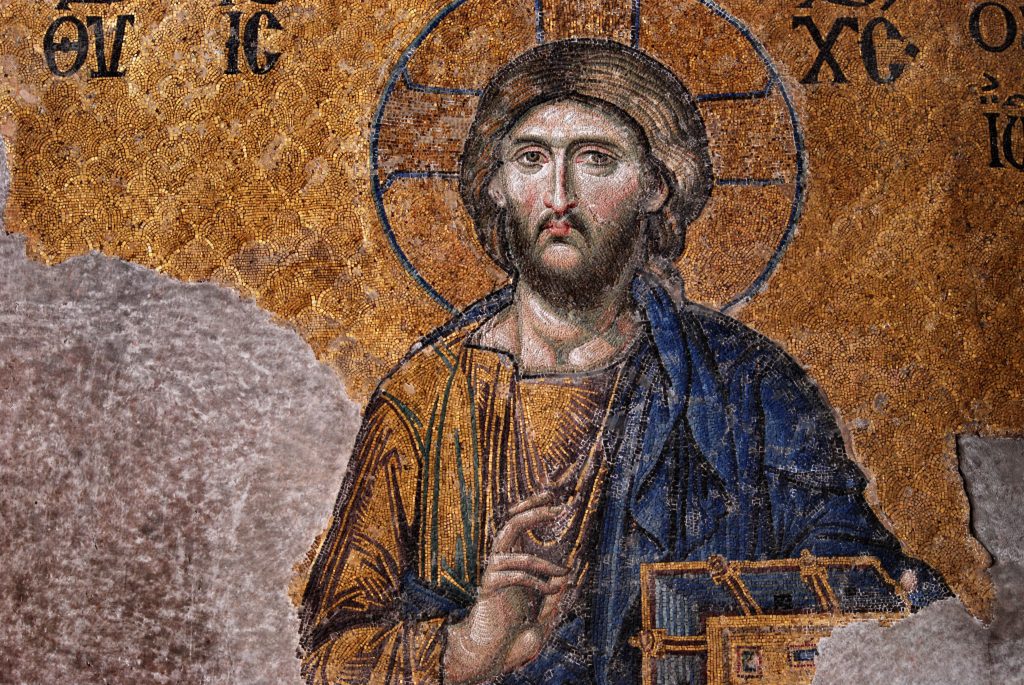
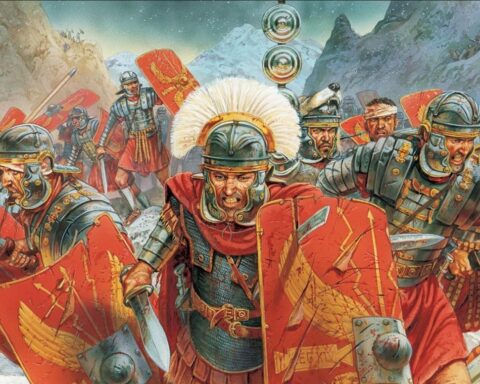
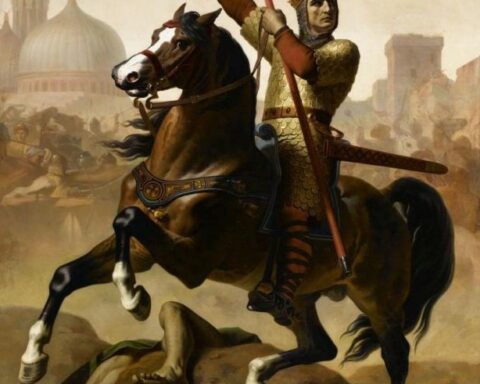
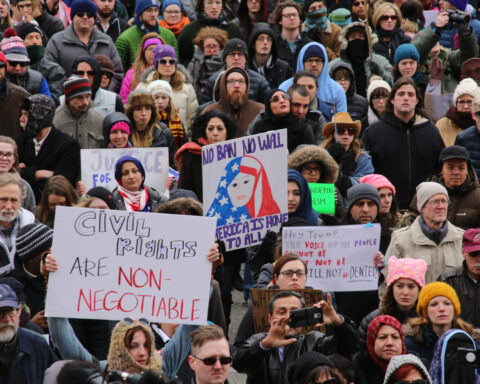
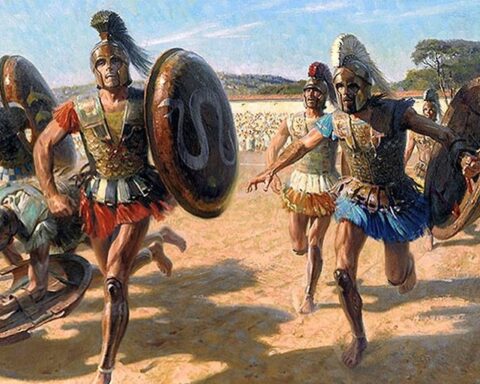
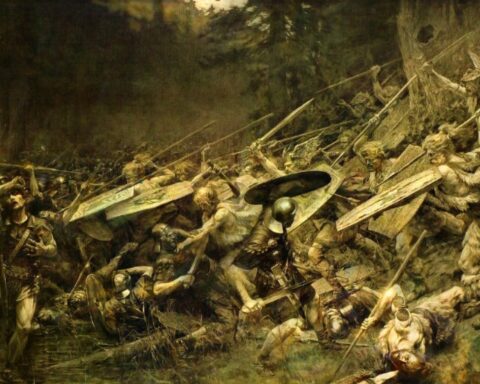
5
I have been reading about Strauss& Howe’s book/conjectures on other sites for a while, but have not read it myself. Could you please give a little more detail about why ” For example, following the Civil War it skips an entire generation, compressing 40 years of cycle into 5. ” ?
After reading this review it looks like I am going to have to break down and read the book for myself to be able to discuss it properly. LOL I’m wondering how they account for long undercurrents and generational quirks (such as the boomers’ obsession with eschatology, “the coming collapse” & post-apocalyptic distopias) within all that.
“Could you please give a little more detail about why ” For example, following the Civil War it skips an entire generation, compressing 40 years of cycle into 5. ” ?”
Absolutely. But I must first note an error on my part: that should have been a 20 year cycle, one full “turning”, not a 40.
In Part 2 of the book the authors present an historical overview of the turnings and generations (oldest to youngest) found therein. Their theory is that certain archetypes, e.g. “Prophets” like the Boomers, in certain positions of power, make a turning work out a certain way. In the case of the Civil War fourth turning, there was a “Prophet” generation (the Trancendentals) in power. And Prophets, because they always consider themselves the center of the universe (t-t-t-talkin’ ’bout my generation), usually lead the nation into all-out war and lots of destruction. This might answer your note about eschatology as well. I think everyone knows deep down that the Boomers are going to screw everything up big time.
One must combine that with the authors’ argument that the archetypal generation arises in large part because of its predecessors’ methods of childrearing. So the cynical “Gilded” (a Nomad archetype) followed the Trancendentals just as the cynical Gen Xers (also a Nomad archetype) follow the Boomers. The self-centeredness of one leads to a cynicism and aloofness in the next, over and over.
Nomads are then followed by Heroes, who are followed by Artists, who are followed again by Prophets. The important thing is that each arises as it does because of the prior’s collective personality.
So taking us to the Civil War saeculum (1794 – 1865), we find that the entire Fourth Turning (and therefore “winter”) is crammed into 1860-5. We also find that instead of a Prophet/Nomad/Hero/Artist generational layout, we have Prophet/Nomad/Artist/Prophet, with the note that “The Civil War saeculum has no Hero archetype”. This would be approximately page 133 in the original hardcover edition, but this “Overview” has no page numbers.
OK, I can buy the idea that 20 years’ worth of destruction was packed into the Civil War and that all the contradictions of the prior age were resolved. I can even buy that there was little time to raise a specific “generation” in that time. Where my problem arises is, whence does the “Progressive” (an Artist archetype) then arise if there is no Hero for it to be molded by?
While the authors claim the shell-shock of their childhood makes them a cautious generation of lawyers and administrators, it rather undermines the argument that archetypes follow one another because the younger is reacting to the older. So Nomads always lead to Heroes, except when they lead to Artists, who always follow Heroes except when they don’t.
I just didn’t find the explanation very convincing, especially given that generational bounds and archetypes are a bit murky overall, and moreso as we read backward in the centuries.
Thanks for the additional insight. I’ve gone ahead and ordered the full book. Knowing nothing since I have only read others’ thoughts and the Infogalactic article, I sense you are correct to be skeptical if they are postulating that the Civil War “fourth turning” lasted only 5 years. The whole “Reconstruction” era must be included in the “Winter”, which would have lasted right up until all the states had not only been readmitted to the Union, but also when Local Rule had been restored to them all, which would put that fourth turning ending in 1877. 1877 would be much more in line with the rest of their timelines, But that would mean they’ve gotten some other things out of whack. Instead, they have moved Reconstruction into the “Gilded Age” – but their dates for that named era (1860-1822) do not fit with the historical “Guilded Age” we’ve all studied in history (1873-ish/1877 – 1900).
As to “no Hero generation”, who do they think *fought* and died in the bloodiest war America has ever been involved in, if not the Heroes/Civics? Who bucked up and went back home or moved out West into still-hostile territories to rebuild their lives after the ungodly interruption of that war? …. so those are the kinds of questions raised already and I haven’t read it yet LOL I won’t say more until I do LOL
^Correction: Strauss-Howe’s Gilded Age is 1860-1882 , not 1822. Typo on my part.
These are all good thoughts. I would just mention that there have been few theories presented in this regard, at least of this magnitude. It only makes sense that Strauss and Howe make some errors. Some errors, here or there, do not mean the whole theory is bogus. It just needs refinement, perhaps.
I tend to think that, on the whole, they are correct. It could just be that while the theory works in general, there are some exceptions (as the missing hero cohort discussed above), and the reason they give is incorrect. Maybe it just missed that time. Who knows?
I agree that they are probably generally correct, while the specifics can always be argued about.
I read it, too. I liked the idea of history being cyclical. But when I looked at their predictions about our time, it said that our young people would put up with less sin and get closer to God. While there is some light in this generation, it has been completely co-opted by the Hollywood hook-up values and the secular ideals of the left. I don’t blame Strauss and Howe for that, but their theory hasn’t held up, either.
FWIW, I think that we are still on the brink of that 4th turning cataclysm. I think that something terrible will happen at the top (Trump assassinated or an aborted coup attempt, for example) and we will have more bloodshed than we might imagine. I have a friend who tells me all the time that he looks forward to this because we will win and it will cleanse us. I hope he is right if it happens. But the problem with his theory is that most revolutions eat their own children and if the bullets start flying, we might well destroy so much of what makes this place great now (I can jump in my truck and drive an hour to see a major league baseball game with very little fear I will get shot at on the way). Once the violence starts, no matter how right we are, there is no way to ensure that it ends quickly or cleanly.
[…] long wave economics, they’re usually talking about the Kondratieff Wave or perhaps even the Saeculum, waves that last on the average 60-80 years from trough-to-trough. But there are lots of other […]
[…] about long wave economics, they’re usually talking about the Kondratieff Wave or perhaps even the Saeculum, waves that last on the average 60-80 years from trough-to-trough. But there are lots of other […]
4.5
[…] globalism. The model had to break at some point – efficiency is brittle. And if this is the Fourth Turning crisis starting to roll in earnest, then history is about to get real again. And […]